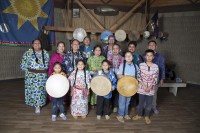This Place Is Our History, Our Beginning, Our Future
We are from this place.
Prior to being rounded up into the mix of Native peoples who make up the Confederated Tribes and Bands of the Yakama Nation, before we were called the Kah-milt-pa Band, before we were even Columbia River Indians, we were just people whose creation took place on NChi-Wana, the Columbia River.
Driving down I-84 on the Oregon side or SR-14 on the Washington side, you probably wouldn’t even notice the place we’re talking about. Sure, you'd see the John Day Dam, stretching across the Columbia River collecting its toll. Maybe you would notice some remnants of the old aluminum smelter site, though certainly not the contamination leached into the ground. If you were particularly astute one day, the wind turbines in the distance, sunlight glinting off of their rotating white blades, might catch your eye. Or perhaps the new pumped storage project, proposed by Rye Development and proclaiming in neon letters, GREEN DEVELOPMENT & JOBS, rattles through your mind. But by this time you have driven past the place, not even seeing the land, just what decades of development have left behind. What a shame to miss this sacred place.
Our stories talk to us about this land.
From the Columbia River all the way up to the ridge, we intimately know this place. We speak about the caretakers of all levels of the earth: like Porcupine, the chief of the four leggeds; or Beaver, who takes care of the water, even the little tiny critters amongst the ground who burrow into the earth; and their chief, White Weasel; or the chief of all birds, Golden Eagle. Our ceremonies are tied to these stories, tied to this particular area, and tied to the timing of the foods that grow and we gather here. The women in our band gather food for subsistence and ceremonies from the bottom near the river to the top of the ridge. Here we find some of our first foods, like celery or desert parsley, signifying the beginning, connecting with our ceremonies and all of the sacred foods that follow on and on through the seasons. First foods, colors, timing and animals weave the web of lifeways and obligations inextricably tied to place and what it means to be a Columbia River Indian.

We know the history of this place and our songs are still with us.
This land surrounds us with culture, with landmarks that have a meaning and a story. Ridges, like the one found here above the John Day Dam, the so-called “empty ridge” that Rye Development wants to excavate and put a 60-acre reservoir on, is one of the places where our spirits go to take our last departure. These ridges are sacred to us. Without them, some spirits don’t make it out of this world and are sent back. We tell the story of this ridge and how it stood above the flooding waters. This ridge is our history, our beginning, our future. How can it be called empty?
Ours is a living culture and we are being cheated by progress. An unrelenting cultural extinction in the name of energy development. So when asked about a new industrial energy project proposal here, at our sacred site, please excuse our skepticism and a sincere No. No, there is no way to configure the project to avoid sacred sites. No, we do not want two massive 60-acre reservoirs dug into the sacred ground here. No, we do not support the Goldendale Energy Storage Hydroelectric Project. We continue to say No, even though history has shown that our voice falls on the deaf ears of progress.
When the John Day Dam was constructed, our fishing village was flooded. Unlike neighboring white towns, we were not provided with alternative housing or compensation, nor did we benefit from the new electricity generation. Our Mothers, Fathers, and Elders were told to leave and many were left homeless for the rest of their lives in the name of energy development progress.
Next, we experienced the wind turbines and the maze of private ownership and no trespassing signs and fences that came with them. One private owner in this area still honors the promises of his forebears, opening the gate of progress to allow us to gather on his land for our ceremonies, but aside from this we have experienced exclusion from gathering here in our home on this ridge down to the river. The next generation will be the first of our people to not be allowed to gather here.
These projects focus on Yakama Nation ceded lands, our usual and accustomed lands. With each new project proposed, we are losing the habitats where our first foods grow and our treaty rights and spiritual ways are being eroded.
Now the next phase of development is upon us, as the Federal Energy Regulatory Commission (FERC) considers licensing Rye Development’s proposed pumped storage project. Moving forward with building the largest pumped storage project in the Pacific Northwest will be the final energy development project that will destroy this area. We have already lost so much. To us, the loss of this place will be a feeling akin to losing Celilo Falls when it was flooded and the despair that followed, knowing that our future grandchildren will never have the experience of being in this sacred place, stepping in the footsteps of the generations of the past who have led us to today.
Respect our voices.
When you ask the question, you must hear the answer, even if you don’t like it. FERC, Rye Development, Washington state: our answer is No, do not build this project on our sacred site.
Read the full newsletter: the formation of Comunidades; Snake River restoration opportunity; Yakama voices against Rye Development; and more!


